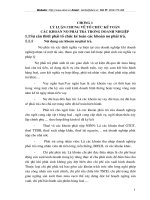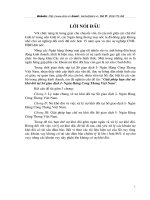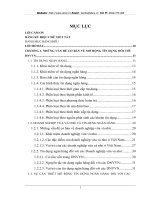No agriculture without water
Bạn đang xem bản rút gọn của tài liệu. Xem và tải ngay bản đầy đủ của tài liệu tại đây (3.49 MB, 27 trang )
No Agriculture without Water
Water for secure and
viable agriculture
@ photo Arthus-Bertrand
Why water is vital for food security
Water needs per person in litres per day
l/day and capita
Essential Abundant
Quality
Drinking
2
4
***
Domestic
40
400
**
1000
5000
*
Food
(Evapotranspiration)
Water use and food production
– About 50% of accessible water resources are currently
mobilized for human use
– Agriculture represents 69% of all water use (85 to 95% in
developing countries) but are the largest consumer
– Irrigation represents less than 20% of cultivated land but
contributes 40% to overall food production
Industry
21 %
Agriculture
93 %
Agriculture
69 %
Industry
4%
Municipal
10 %
Municipal
3%
Water withdrawal
Water consumption
Freshwater withdrawal for Agriculture
% Agricultural
withdrawal
No data
0-5
5-10
10–20
20–40
>40
Map showing agricultural water withdrawal as percentage of renewable water resource in
1998 by country, where withdrawals for agriculture are critically high (category 5) and
indicative of water stress (category 4).
800 millions undernourished people
% undernourished
No data
< 2.5
2.5–5
5–20
20–35
>35
Percentage of undernourished people by country (1997-1999). Prevalence of undernourishment
is measured by the share of a country's total population that is undernourished
Sources of growth in crop production
To meet the food demand between today and 2030 an increase in production of
about 50 % is needed. FAO estimates that for 93 developing countries this
increase will come from:
Irrigation efficiency and withdrawal:
in 1998 and 2030
FAO estimates (for 93 developing countries) that in 2030:
- Irrigation efficiency is expected to improve from 38 to 42 %
- water withdrawal is expected to grow by about 14 percent
sub-Saharan
Latin
Africa
America
Near East/
North Africa
South
Asia
East
Asia
93 developing
countries
Irrigation efficiency (%)
1998
33
25
40
44
33
38
2030
37
25
53
49
34
42
Irrigation water withdrawals as a percentage of renewable water resources
1998
2
1
53
36
8
8
2030
3
2
58
41
8
9
No Agriculture without Water
New approaches in
agricultural water
management
Improving rainfed production
• Soil and water conservation techniques
– Reduce run-off and increased water infiltration
• contour stripping, terracing, micro-basins
– Increased soil moisture storage
• Increased soil and rooting depth
• improve soil structure
• Crop selection
• Storage for supplemental irrigation
– Tanks or ponds, groundwater
Improving water production
• Shift in cropping pattern (from rice to wheat)
• Increasing irrigation efficiency (60% water losses in irrigation)
- Water saving technologies and management
• Use of non-conventional water sources:
-treated waste water
-de-salinizated water
• Drainage
Improving management
-at scheme level
Irrigation modernization, moving from:
• Protective to productive irrigation
• A supply-oriented to service-demand approach
• A centralised to a decentralised irrigation management
Empowering people:
• Allocation of land and water resources to users
(men and women)
• Power and responsibilities to the users
(water use associations)
Improving management
at farm level
• Improving productivity at farm level implies the
following actions
• improving water use efficiency
• diversify crops
• This is done through:
• training and information
• investment in water saving technologies
• improved market opportunities and credit.
Improving management and policies
-at national and international level
Reform of national water and land policies
• Ensuring fair and equitable access
• Secure water rights
• Water management at the river basin (upstream-downstream)
• Provide incentives to conserve water to reduce losses
• Recognising the full value while protecting the poor
• Regulations for protection of aquifers, rivers, lakes and wetlands
(quality and quantity)
International agreements on trans-boundary water resources
Investments
Investments and financing sustainability
Investment costs per ha
Include technical and institutional costs. Operation and maintenance cost are
estimated to be 10 % of the investment costs
No Agriculture without Water
Pro-poor and
affordable agriculture
water management
Role of water in poverty alleviation
• Raise food supply and cash income
• Reduced migration from rural areas to cities
• Irrigation allows for timely, secure increase in production without increasing
the land holding
• Conditions
– Affordable technologies
– Local manufacturing capacity
– Land, water and technology should be under farmer control
– low operation and maintenance costs
– Easy to install and to operate
Pro-poor policies, actions and technoloies needed.
Case 1: Conservation Agriculture
Alternative forms of tillage prevents crust formation and maintains
an organic soil cover
Reduced erosion and water losses
• Traditional approaches in South America
• Requires animal use and high management skills
Case 2: Water harvesting
Collecting of water in structures ranging from small furrows to
dams Allows farmers to conserve rainwater and direct it to crop
for increased food security in drought prone areas
• Traditional approaches in arid and semi-arid countries
• High productivity
• Less risks
• Vulnerable to dry periods
• Requires water use groups
Example: Keita valley in Niger
tree plantation with trenches
Case 3: Low-cost well drilling
Hand drilling technique from Asia
helps farmers to improve their access to water
• Simple and manual
• Low cost
• Limited drilling depth
Case 4: Water lifting
Simple pumping technologies combined with improved surface
water distribution techniques
helps farmers to manage the water better and reduce losses
• Simple
• Low costs
• No risk for groundwater
overexploitation
• Requires time and cultural
acceptance
Example: Treadle pumps From Asia to Africa
Case 5: Family-kit drip irrigation
Complete drip irrigation system for 50-2500 m2
household food security, income from high value crops and
major reduces in water losses
No Agriculture without Water
Managing the
environmental and health
impacts of irrigated
agriculture
Impacts of irrigation
Overuse and misuse of water in irrigated agriculture
deprive downstream users (inc. environment)
Poor management of irrigation and lack of sufficient drainage
waterlogging and salinity problems
Drawbacks of drainage
risk for flooding downstream and reduced groundwater recharge
Overuse of groundwater
falling groundwater levels
Waterlogging
Salinization
Health hazards
Mitigating of adverse effects
On health and environment
• Water conservation
• Reuse of drainage water
• Treatment of drainage water
• Safe disposal of drainage water
• Reducing favorable conditions
for vector-born and waterrelated diseases by:
– improved management of irrigation systems
(decrease breeding sites)
– regular maintenance of irrigation systems.
Prevention
• Prevention of water-borne and water-washed diseases can be
done through:
– Education , training, media campaigns
– Improved drinking water supplies, sanitation and housing
– Strict control over the wastewater effluent quality being
discharged
• Problem: In many countries, treatment facilities are
inadequate or lacking altogether.






